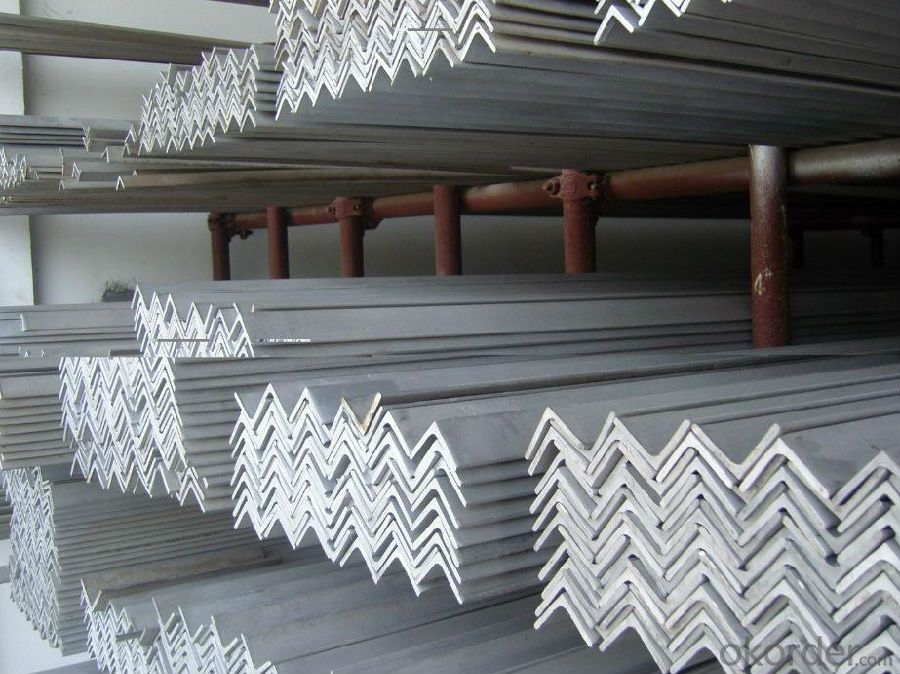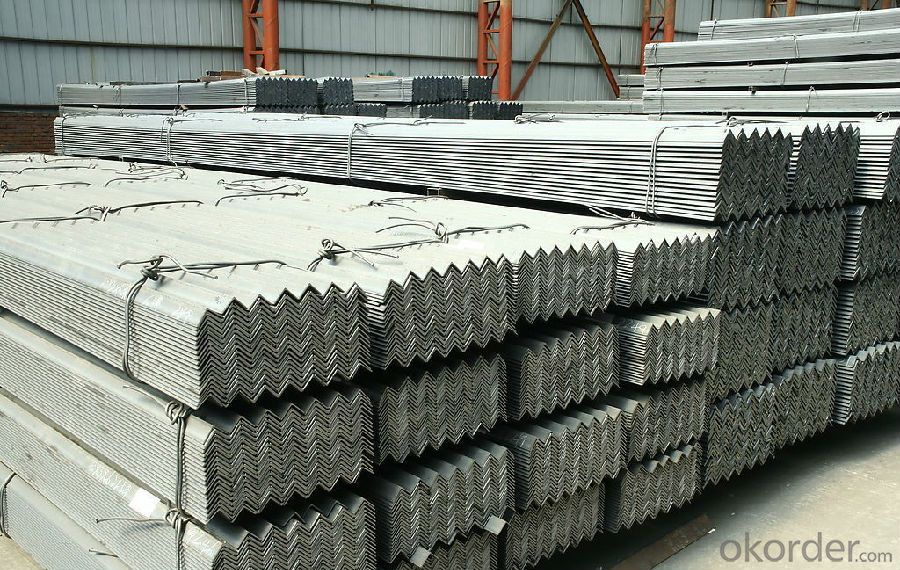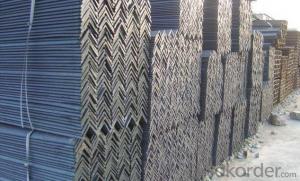Steel Equal Angle with Good Quality 100*100*6.0-12.0mm
- Loading Port:
- Tianjin
- Payment Terms:
- TT OR LC
- Min Order Qty:
- 50 m.t
- Supply Capability:
- 15000 m.t/month
OKorder Service Pledge
OKorder Financial Service
You Might Also Like
Item specifice
Product Description:
Specifications of Steel Equal Angle with Good Quality 100*100*6.0-12.0mm:
1. Invoicing on theoretical weight or actual weight as customer request
2. Length: 6m, 9m, 12m as following table
3. Sizes

| Size(mm) | Mass(Kg/m) | Size(mm) | Mass(Kg/m) |
| 100*100*6.0 | 9.366 | 100*100*10.0 | 15.12 |
| 100*100*7.0 | 10.83 | 100*100*12.0 | 17.898 |
| 100*100*8.0 | 12.276 |
Payment terms:
1).100% irrevocable L/C at sight.
2).30% T/T prepaid and the balance against the copy of B/L.
3).30% T/T prepaid and the balance against L/C
Material details:
Grade | Element (%) | ||||
C | Mn | S | P | Si | |
Q235 | 0.12—0.20 | 0.3—0.7 | ≤0.045 | ≤0.045 | ≤0.3 |
Usage & Applications of Steel Equal Angle with Good Quality 100*100*6.0-12.0mm:
According to the needs of different structures, Angle can compose to different force support component, and also can be the connections between components. It is widely used in various building structures and engineering structures such as roof beams, bridges, transmission towers, hoisting machinery and transport machinery, ships, industrial furnaces, reaction tower, container frame and warehouse etc.
Packaging & Delivery of Steel Equal Angle with Good Quality 100*100*6.0-12.0mm:
1. Packing: it is nude packed in bundles by steel wire rod
2. Bundle weight: not more than 3.5MT for bulk vessel; less than 3 MT for container load
3. Marks:
Color marking: There will be color marking on both end of the bundle for the cargo delivered by bulk vessel. That makes it easily to distinguish at the destination port.
Tag mark: there will be tag mark tied up on the bundles. The information usually including supplier logo and name, product name, made in China, shipping marks and other information request by the customer.
If loading by container the marking is not needed, but we will prepare it as customer request.
Production flow of Steel Equal Angle with Good Quality 100*100*6.0-12.0mm:
Material prepare (billet) —heat up—rough rolling—precision rolling—cooling—packing—storage and transportation
FAQ:
Q1: Why buy Materials & Equipment from OKorder.com?
A1: All products offered byOKorder.com are carefully selected from China's most reliable manufacturing enterprises. Through its ISO certifications, OKorder.com adheres to the highest standards and a commitment to supply chain safety and customer satisfaction.
Q2: How do we guarantee the quality of our products?
A2: We have established an advanced quality management system which conducts strict quality tests at every step, from raw materials to the final product. At the same time, we provide extensive follow-up service assurances as required.
Q3: How soon can we receive the product after purchase?
A3: Within three days of placing an order, we will begin production. The specific shipping date is dependent upon international and government factors, but is typically 1 to 2 months.
Q4: How many tons can be loaded into one 20ft container?
A4: Around 23—25tons
Images of Steel Equal Angle with Good Quality 100*100*6.0-12.0mm:


- Q:Can steel angles be used in staircases?
- Steel angles are indeed suitable for use in staircases. Due to their strength and versatility, they are commonly employed as structural components in construction. In staircases, steel angles serve to offer support and stability to both the steps and handrails. They are frequently utilized as stringers, inclined structural members that uphold the treads and risers of the staircase. Moreover, steel angles can be utilized to reinforce the connections between the treads and risers, thereby ensuring the staircase's structural integrity. Furthermore, steel angles can function as handrails or balusters, providing a secure and long-lasting railing system. All in all, steel angles present a dependable and cost-effective solution for constructing staircases that can withstand heavy loads and meet the necessary safety standards.
- Q:What are the different grades of steel angles?
- There exists a variety of steel angle grades, each possessing its own distinct properties and characteristics. Among the most frequently utilized grades are A36, A572, and A588. The grade known as A36 steel angle is the most commonly employed due to its exceptional strength and versatility. Possessing a minimum yield strength of 36,000 psi, it is suitable for a wide array of applications. A36 steel angle is frequently employed in construction projects and serves as structural support in buildings and bridges. Another extensively utilized grade is A572 steel angle, renowned for its superior strength and durability. With a minimum yield strength of 50,000 psi, it is ideal for heavy-duty applications. A572 steel angle is frequently employed in construction projects necessitating high strength, such as the erection of skyscrapers and large buildings. A588 steel angle, on the other hand, is a corrosion-resistant grade often employed in outdoor and marine environments. Engineered to withstand exposure to harsh weather conditions and corrosive elements, it possesses a minimum yield strength of 50,000 psi. A588 steel angle is commonly applied in coastal regions and in the construction of bridges and other structures exposed to saltwater or high humidity. These are merely a few examples of the diverse assortment of steel angle grades available. The selection of a grade hinges upon the specific application and the desired properties, including strength, corrosion resistance, and durability. It is essential to consult a professional or adhere to industry standards when choosing the appropriate grade of steel angle for a particular project.
- Q:How do you prevent corrosion on steel angles?
- One effective method to prevent corrosion on steel angles is by applying a protective coating such as paint or zinc. This barrier creates a physical barrier between the steel and the corrosive elements in the environment, preventing direct contact and reducing the chances of corrosion. Regular maintenance and inspection, along with promptly addressing any signs of damage or rust, can also help prevent corrosion on steel angles.
- Q:Do steel angles require any special maintenance?
- Yes, steel angles require regular maintenance to prevent rusting and corrosion. This includes cleaning, inspecting for any damage or wear, and applying protective coatings or paints as needed. Additionally, proper storage and handling practices should be followed to avoid any potential damage to the steel angles.
- Q:What is the fire resistance rating of steel angles?
- The fire resistance rating of steel angles depends on various factors such as the size and thickness of the angle, the type of steel used, and the specific fire protection measures implemented. Steel is inherently fire-resistant due to its high melting point and low thermal conductivity. However, the fire resistance rating can be enhanced by applying fireproofing materials, such as intumescent coatings or fire-resistant boards, to the steel angles. These fire protection measures can significantly increase the fire resistance rating of steel angles by providing insulation and slowing down the transfer of heat to the steel. The specific fire resistance rating can vary based on the thickness and type of fireproofing materials used. For example, a steel angle with a certain fireproofing coating may have a fire resistance rating of 60 minutes, meaning it can withstand exposure to fire for up to 60 minutes before losing its structural integrity. It is important to consult local building codes, regulations, and fire safety standards to determine the specific fire resistance requirements for steel angles in a particular application. These standards can provide guidance on the necessary fire protection measures and the minimum fire resistance ratings that need to be met in different construction scenarios.
- Q:Are steel angles resistant to dynamic loads?
- Yes, steel angles are generally resistant to dynamic loads. Due to their structural properties and high strength-to-weight ratio, steel angles can effectively withstand dynamic forces such as vibrations, impacts, and other fluctuating loads without significant deformation or failure. However, the specific resistance to dynamic loads may vary depending on the size, grade, and design of the steel angle.
- Q:How do you protect steel angles from chemical exposure?
- To protect steel angles from chemical exposure, various methods can be employed. One effective approach is to apply a protective coating such as enamel or epoxy paint, which acts as a barrier against corrosive chemicals. Additionally, using corrosion-resistant materials such as stainless steel angles or galvanized coatings can enhance their resistance to chemical exposure. Proper storage and handling practices, ensuring minimal contact with corrosive substances, can also contribute to protecting steel angles from chemical damage.
- Q:How do you calculate the buckling capacity of a steel angle?
- The buckling capacity of a steel angle can be calculated using the Euler's formula, which takes into account the properties of the steel angle section, such as its length, moment of inertia, and modulus of elasticity. By applying this formula, the critical buckling load of the steel angle can be determined, giving an estimate of its buckling capacity.
- Q:How do steel angles contribute to the overall stability of a structure?
- Steel angles contribute to the overall stability of a structure in several ways. First and foremost, steel angles are commonly used as structural members in various applications such as building frames, bridges, and towers. Their L-shaped profile provides excellent strength and load-bearing capabilities, making them ideal for supporting heavy loads and resisting bending or buckling. One of the primary functions of steel angles is to provide structural support and stability by distributing the load evenly across different components of the structure. By connecting various elements together, such as beams, columns, and girders, steel angles ensure that the weight and forces acting on the structure are effectively transferred and resisted, preventing any potential collapse or failure. Moreover, steel angles enhance the overall rigidity and stiffness of a structure. By adding diagonal bracing elements made of steel angles, the structure becomes more resistant to lateral forces such as wind or earthquakes. These diagonal braces create a triangular configuration, which is known for its stability and ability to withstand horizontal loads. This increased stability and resistance to lateral forces significantly contribute to the overall safety and durability of the structure. Additionally, steel angles play a crucial role in mitigating torsional forces in a structure. Torsion occurs when one end of a structural member is twisted while the other end remains fixed, resulting in a twisting moment being applied to the structure. Steel angles can be strategically placed and connected to resist these torsional forces, preventing any excessive twisting or deformation that could compromise the stability of the structure. In summary, steel angles are essential components that contribute to the overall stability of a structure in multiple ways. They provide structural support, distribute loads efficiently, enhance rigidity, resist lateral forces, and mitigate torsional forces. By incorporating steel angles into the design and construction of a structure, engineers can ensure its long-term stability, safety, and durability.
- Q:Can steel angles be used for machine guards?
- Yes, steel angles can be used for machine guards. Steel angles are commonly used in the construction industry for their strength and durability. They can be easily fabricated and installed to create a protective barrier around machinery, ensuring the safety of workers and preventing accidents. The versatility of steel angles allows them to be customized to fit various machine sizes and shapes. Additionally, steel angles offer good impact resistance and can withstand heavy loads, making them suitable for use in machine guarding applications.
1. Manufacturer Overview |
|
|---|---|
| Location | |
| Year Established | |
| Annual Output Value | |
| Main Markets | |
| Company Certifications | |
2. Manufacturer Certificates |
|
|---|---|
| a) Certification Name | |
| Range | |
| Reference | |
| Validity Period | |
3. Manufacturer Capability |
|
|---|---|
| a)Trade Capacity | |
| Nearest Port | |
| Export Percentage | |
| No.of Employees in Trade Department | |
| Language Spoken: | |
| b)Factory Information | |
| Factory Size: | |
| No. of Production Lines | |
| Contract Manufacturing | |
| Product Price Range | |
Send your message to us
Steel Equal Angle with Good Quality 100*100*6.0-12.0mm
- Loading Port:
- Tianjin
- Payment Terms:
- TT OR LC
- Min Order Qty:
- 50 m.t
- Supply Capability:
- 15000 m.t/month
OKorder Service Pledge
OKorder Financial Service
Similar products
New products
Hot products
Related keywords



























